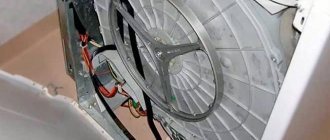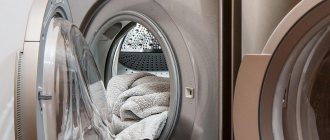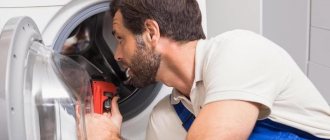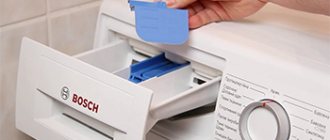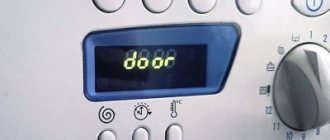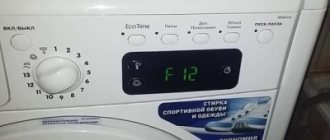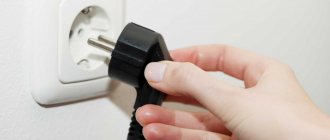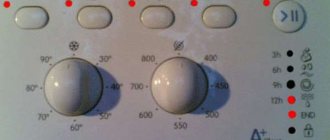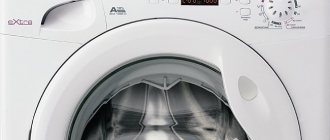Published: 14 Oct 2020
Although advertising promises with all its might that the washing machine operates silently, in reality this is not the case. SMA is a complex household appliance, some of its parts move and rotate, and therefore make noise. This is the sound of normal operation, but sometimes owners notice that something is knocking loudly inside the washing machine. It can rattle in different ways:
- a knocking sound appears during washing or is heard during the spin cycle of the washing machine;
- The knocking sound in the washing machine is heard only in the spin mode.
What to do if you hear unusual knocking sounds? First you need to exclude external causes.
The washing machine knocks when washing and spinning
If your washing machine is knocking, there may be several reasons for this knocking: improper installation of the machine itself, problems with one of the counterweights, a loose power filter, a slipped shock absorber or a broken spring, foreign objects between the drum and the tub, as well as problems with bearings.
Article on the topic: Why does the washing machine knock and vibrate?
First of all, before you panic, take a close look at the laundry in the washing machine. It happens that during the washing process, laundry rolls up into one laundry ball. This happens especially often when you wash a set of bed linen, and the duvet cover serves as an excellent environment for the formation of this lump. In this case, during the spin cycle, the washing machine jumps, jumping and moving all the built-in equipment in the neighborhood.
If there are no problems with the laundry, but there is still a knocking noise, then to figure out exactly why the washing machine is knocking and what to do about it, read below.
Unevenly distributed laundry
This problem is typical for older models. Modern devices practically do not rattle, of course, if they are in good working order and installed correctly. Good alignment is facilitated by the presence of electronics, which allows you to distribute things more evenly and prevent imbalance in the drum. Old devices cannot assess how well the drum is centered, and whether there are crumpled laundry in it. Spinning occurs in any case, and then the drum may knock on the walls or other elements of the washing machine.
We suggest you familiarize yourself with: The washing machine does not take in water
Make sure the machine is level
If the machine's legs are not level, it will begin to shake and knock during the spin cycle. To fix the problem:
Make sure the machine is on a level surface. It often happens that one leg ends up in the groove between the tiles or stands on the baseboard. Move the machine so that it is on a level surface.
Move the machine away from the wall and tilt it so that the front legs are visible. Have someone hold the machine, otherwise you will not be able to do the following steps, or place a block of wood under it. Be careful not to touch wires or cables.
Make sure the legs are the same length. You can use a ruler, measuring tape, or tape. Measure the height to the nearest millimeter - even a small difference in the legs will lead to significant swaying and knocking. If the legs are the same length, make sure they fit snugly on the floor.
If the legs are of different lengths, adjust them in height. To do this, it is enough to simply twirl them by hand. But in most machines they are fastened with a nut, which must be loosened with a wrench in order to shorten or lengthen the legs. Make sure you screw the nut back to adjust the height. Alternatively, you can place a folded piece of paper or a piece of carpet under the shorter legs.
If you still can’t balance the machine, you can place special rubber vibration absorbers under the legs, sold in hardware stores.
Article on the topic: Where are the shipping bolts in the washing machine?
Of course, you can also use a building level by placing it on the top of the washing machine. But this may not work if the floor is on a slope. So first check the levelness of the floor using the same building level.
Diagnostics
To fix a problem, you must first identify it. Correct diagnosis is half of a successful repair. Before contacting a service center, some faults can be determined independently.
- If you hear a knocking sound when the drum rotates, it is most likely that change has fallen out of your pocket or the clothing has not been turned inside out so that the buttons and zippers are turned inward.
- If you hear a strong squeaking sound when the car picks up speed, it is likely that the bearing is worn out. To check this version, you need to open the hatch of the washing machine, press on the inner edges of the drum and scroll. Some skipping and cracking may be felt. It is likely that the bearing is faulty.
- Sometimes you can hear a knock on the case during operation. A possible cause is an imbalance in the rotation axis. To exclude or confirm this breakdown, you need to check the drum play: if it is too large, then this is the problem.
- If the machine begins to make a lot of noise and vibrate, then the counterweight mounts may have become loose.
- When you open the door, you can see that the tank is slightly tilted. When you press it, it hits the walls or other parts of the machine.
- If the washer made a very loud noise while draining the water and stopped working, then most likely the pump has broken down.
- To identify the incorrect installation of the machine, you just need to press one of its corners - it should not swing. You can also check it with a building level.
What causes the vibration?
Everyone knows that top-loading washing machines are much quieter than front-loading washing machines. Why? Yes, because when the drum of a front-loading washing machine rotates, centrifugal force presses on the side walls, rocking the body. And the faster the drum rotates and the more laundry there is, the stronger the impact of centrifugal force and, accordingly, the more sensitive the vibration. Everything would be fine if vibration did not have a comprehensive harmful effect:
- it destroys machine parts, gradually rendering it inoperable;
- it is accompanied by a hum and rumble, which can be unpleasant not only to the owners, but also to the neighbors;
- it has a negative impact on the flooring and nearby furniture.
There have been cases when, due to the vibration of a working washing machine, glasses and plates flew off the countertop under which it was installed onto the floor and were broken into pieces.
In general, vibration during the spin cycle of a Samsung washing machine, or any other one, is an inevitable evil that you have to put up with. It’s okay, if the vibration occurs slightly during operation of the machine, it is within normal limits. In principle, no one suffers from such an impact, but what if the vibration is strong, and even accompanied by loud unnatural noises? Now is the time to sound the alarm and see what could potentially cause such a problem. The options are as follows:
- the machine is installed on an extremely unstable piece of furniture or flooring;
- things were loaded into the car incorrectly;
- they forgot to unscrew the shipping bolts, but started the machine;
- a foreign object got into the tank of the Samsung washing machine;
- the bearings were seriously damaged or completely destroyed;
- one of the dampers broke;
- the counterweight has been destroyed or displaced.
Article on the topic: When the washing machine heats the water
Installation in violation of the rules
Experts never tire of repeating that the washing machine must be leveled on a stable, hard surface. It is not necessary for such a surface to be perfectly flat, because small differences can be compensated for by twisting the legs. But it must be as strong as possible so that it does not bend, sway or even creak under the weight of an adult man.
When installing a washing machine, you cannot part with the building level. Place a level on the lid of the washer and check it every time you tighten the legs of the “home assistant”. It has been proven that even slight distortions of the body in one direction or another have an impact later, significantly increasing the vibration of the Samsung washing machine during spinning.
Before using your new washing machine, be sure to remove the shipping bolts. Otherwise, you not only risk damaging the drum of the new machine, you also doom yourself to listen to the clanging and feel the monstrous vibration at the moment when the machine starts spinning the laundry at a speed of over 1000 rpm. You can read more about installation rules in the article Installing and connecting a washing machine.
Operational errors
Vibration during spinning can also occur if you use your Samsung washing machine incorrectly. What seems absolutely unimportant to you may ultimately play a fatal role. What is it about?
Article on the topic: Where can you sell your old washing machine in Samara
First, pay attention to how you fold the laundry into the drum of your Samsung washing machine. You cannot lump up a large number of things or one bulky item. Dirty laundry must be evenly distributed in the drum, otherwise there will be an imbalance and, as a result, strong vibration.
Secondly, before putting things into the drum, check their pockets to ensure that foreign objects do not get stuck in the tank and cause loud noises and vibrations. Thirdly, put all things potentially dangerous for the washing machine in a washing bag, and only then put them in the drum of the Samsung washing machine. There have been cases when a bra wire got stuck in the tub of a washing machine and jammed the drum for some time, causing clanging and strong vibration.
Everything could have ended even worse, because the metal wire from the bra is quite sharp, and the wall of the tank is made of plastic. There have been cases when such a bone pierced the wall of the tank, breaking its tightness.
Bearings and dampers
All of the above can be called minor troubles that can be eliminated in a matter of minutes.
But it happens that vibration and strong, unnatural sounds during spinning are caused by a serious breakdown or manufacturing defect. In essence, we are talking about only two failures: bearing failures and damper failures. You can change the damper yourself; just remove the back wall of the Samsung washing machine and we will have access to the broken part and its fasteners. At least, if we can’t repair it, then at least we can change it.
Article on the topic: Which washing machine to choose Siemens or Bosch
For those who don’t know, a damper is a part similar to a shock absorber that performs its functions.
With bearings the situation is much more complicated. To change them, you will have to disassemble the entire washing machine, including the tank. If you are an experienced DIYer who is not afraid of manual labor, go ahead and try changing the bearings with your own hands, our publication will help you. If you are not used to repairing equipment yourself, it would be better to contact a specialist.
In conclusion, we note that a slight vibration emanating from a Samsung washing machine during spinning is quite normal. But if the washer starts to shake very strongly, you need to look for the cause of the problem. It is possible that you are dealing with a serious malfunction. Luck with searching!
Noise Level Standards
The noise level of a washing machine of a certain model is specified in its instructions. It depends on what the drive is:
- in the belt version, its variations are from 60 to 72 dB (decibels);
- with the direct drive option, the threshold is reduced - from 52 to 70 dB.
What do these numbers say? The fact is that the user will still hear the operation of such a device, and absolutely silent washing machines do not exist. The technique works, but such audibility should not create discomfort. If such a feeling occurs, the device is clearly not working. And it’s good if the reasons turn out to be not very serious.
Malfunction related to counterweight
The washing machine may also knock due to a faulty counterweight. A counterweight is a special weight that is fixed at the bottom inside the machine body. It consists of concrete and is necessary in order to dampen the vibration of the machine during spinning and other operations. During prolonged use, the fixation may become loose. Therefore, the counterweight may come into contact with the housing, causing a knock. This often happens during the process of squeezing out the laundry.
If the whole point is a weak fastening, then you just need to tighten the bolts properly. But if, upon opening the body of the machine, you see a broken or broken counterweight, then tightening the bolts is not enough. To solve this problem, you need to order a new counterweight and replace the one that broke.
The danger of self-repair
In any case, if unusual sounds appear during operation of the washing machine, you should stop using it and call a technician. It should be noted that knocking in the car can be eliminated without a lot of time and family budget . But independent repairs at home without the appropriate knowledge and skills can turn into a real accident and aggravate the problem so much that there will be a need to purchase a new unit. Therefore, it is better to seek help from a specialist than to cause even more damage to the car.
The washing machine drum is knocking
The knocking of the washing machine drum during spinning or during washing can be caused by two reasons:
Article on the topic: How to turn on the indesit wisl 103 washing machine
Debris got into the space between the drum and the tank - during the washing process, a bra bone, coins, paper clips or other small parts that you tried to remove from your pockets could get into the drum of the washing machine. These parts can penetrate the gap between the cuff and the drum and enter the tank. During washing, they are in the space between the poppy and the drum and are constantly in contact with both, which causes knocking.
In order to remove the items, you will have to remove the front or back cover of the washing machine (depending on the model) and remove the heating element. Through the hole that appeared in place of the heating element, you can remove all excess debris.
The second reason for the knocking of the washing machine drum can be wear of the bearings ; usually the knocking is also accompanied by a squeaking sound.
More often than not, creaking precedes knocking, so if you understand that this is the reason, then you should replace the bearings, you can read how to do this on our website. Why.
— the drum of the washing machine rattles. — The washing machine makes noise when spinning. — the washing machine rattles. — The washing machine drum is noisy. — strong vibration of the washing machine during spinning. — The washing machine knocks during the spin cycle. — the washing machine jumps during the spin cycle — a humming sound when the washing machine drum rotates. — During the spin cycle, a knocking sound is heard in the washing machine. — the washing machine hums during the spin cycle like an airplane. Article on the topic: How to restart a washing machine
Our operator received a call:
— My washing machine constantly tries to escape from the bathroom, as if it doesn’t like the place! She shakes, jumps, stubbornly moves towards the exit from the bathroom, and she has to be driven back almost with a kick. No, well, that's normal. Let your specialist come and do something about it! — Apparently, your machine hasn’t liked living in the bathroom since its purchase. - Yes, but over the years she breaks free more and more persistently. Sometimes she gets so angry that you have to hold her down with your hands! Maybe let him run to the trash heap under his own power; I’ll buy a new car - more flexible and not so capricious. “Everything is just like people: with age they become grouchier and grumpier!” But unlike old people, who are unlikely to be corrected, things are much better with washing machines.
Essentially, this is a disease of almost all narrow (33-45 cm deep) washing machines, regardless of the manufacturer. There is very little space inside the machine body, and the existing counterweights (obviously insufficient) cannot dampen the vibration that occurs during spinning, when the drum reaches maximum speed. The reason for this is the laundry, which is distributed unevenly along the walls and shifts the center of gravity of the drum, causing strong vibrations.
Engineers, of course, know about this, and therefore they long ago came up with the idea of hanging the tank on spring mechanisms designed to compensate for vibration. And, I must say, this works on wide washing machines, but the trick didn’t work on narrow ones - they still jump like mountain sheep.
Article on the topic: How much does it cost to repair washing machines in Yaroslavl
But if you happen to be the owner of such a “beast,” do not despair ahead of time. Manufacturers seemed to come to their senses and, realizing their shortcoming, released special stands for the legs of the washing machine, made of soft plastic and ensuring a tight fit (and even sticking) to the floor surface, and with the other side - reliable fixation to the legs. This helped: now the machine stops moving chaotically around the room.
So, we have dealt with one reason, our washing machine repair technicians believe that several more reasons can be eliminated without their help: 1. Eliminate unbalanced laundry. 2. Tighten loose counterweight fastenings. 3. Check the engine mounting. 4. Make sure that the shipping bolts have been removed, otherwise unscrew them.
However, there are a number of reasons that cause noise, hum, vibration, knocking and even thunder in washing machines, which have nothing to do with mountain goats and airplanes, which can only be eliminated by specialists: 1. Faulty, cracked shock absorbers of the washing machine. 2. Broken washing machine tank suspension spring. 3. Mechanical damage to the counterweight. 4. Wear and play of bearings.
Our service center technicians for repairing washing machines at home work seven days a week and on holidays from 10-00 to 22-00 (working hours are shifted by agreement with the client). Operators of the service center for the repair of washing machines will answer all your questions about the repair of washing machines, draw up an approximate repair estimate, call tel.
Article on the topic: What is a centrifuge in a washing machine
If the washing machine rattles, knocks, hums, jumps, vibrates: AEG (AEG), Ardo (Ardo), Ariston (Ariston), Asko (Asko), Beko (Beko), Bosch (Bosh) (Bosch), Brandt (Brandt) ,Candy, Daewoo, Gorenje, Electrolux, Indesit, Nansa, Kaiser, LG, Miele Siemens, Samsung ), Vestel (Vestel), Whirlpool (Whirlpool), Zanussi (Zanussi) - the list is incomplete, the washing machine repair technicians of our service center will help you.
Failure of shock absorbers (dampers, springs)
A knocking sound in the washing machine may occur if, as a result of prolonged and intensive use, the springs have stretched or the shock absorbers have weakened. These elements are designed to dampen strong vibrations of the tank during spinning. Budget models of washing machines use only shock absorbers.
More modern and expensive models use a combination of dampers installed at the bottom of the tank and springs on which it is suspended from the top of the body.
As for springs, the situation here is very simple. Definitely replace, and no alternative options. It is better to buy dampers and shock absorbers and install new ones. However, if you want to work and don’t want to spend money, then you can try to repair it yourself. As a rule, breakdowns of these parts can be as follows:
- Wear gaskets: cut from rubber of appropriate thickness.
- Broken rod: solder (temporary measure, use the washing machine without spinning).
- Shock absorbers may additionally have a cracked return spring: replace with a new one
Important!
Deciding whether or not to fix these breakdowns should be based on their criticality. But, in my experience, it is better to install new parts. Moreover, even if one damper fails, a pair will have to be replaced. This will guarantee that further operation will be long-lasting and problem-free.
What exactly is in front of you, a damper or a shock absorber, is difficult to say without disassembling it. You need to focus on the presence of upper springs in the washing machine.
First you need to diagnose the damage to the shock absorbers. To do this, remove the top cover of the washing machine. On most front-loading models, it is removed in the same way. Two screws are unscrewed from the back of the case, and the cover itself is slightly pushed forward. Inside you need to identify the tank (plastic, white, round, large) and press it with a little force and release it sharply. If the tank takes its original position immediately without unnecessary movements, then the dampers and shock absorbers are in order. If oscillatory movements in different directions continued for some time, then it is necessary to begin repairs.
Sequence of actions for replacing dampers or shock absorbers:
- After diagnostics, the top cover of the washing machine has already been removed.
- We remove the front instrument panel (how to do this was in the previous section).
- We bend the sealing collar and the metal clamp that presses it. Carefully pry it up with a screwdriver and remove it.
- Unscrew the hatch lock bolts. The official name of UBL is a hatch blocking device. Disconnect the wires from it and pull it out.
- Find the screw heads of the front panel and unscrew them.
Removing the Damper
To quickly and easily remove a damper or shock absorber, perform the following steps:
- We put a nut on the plastic rod to fold the latches.
- On the other side, carefully pull with pliers.
- Simply unscrew the bolt at the bottom.
When the knocking is not associated with a breakdown
Sometimes the sound does not come from inside the washer. The cause of noise is in the environment or external elements of the SMA.
- The machine is close to furniture or a wall. According to the installation rules, there must be a gap between the case and adjacent objects if the equipment is not built-in. When everything is standing end to end, due to vibration, the SMA can knock on the surface nearby. Move the equipment aside or place a shock absorber between the body and the wall. For example, a rubber or foam seal with an adhesive backing.
- The washing machine hose is knocking . Another source of sound is the drain hose. If it is poorly secured and loose, it can knock on the body of the washer. Check the hose and secure it tightly to the body.
Sometimes it rattles inside the machine, but the reason is not in it, but in the laundry.
- Clothes fittings are knocking. There are metal or plastic parts on clothes: zippers, buttons, trim. Such items need to be turned inside out or placed in a washing bag in the machine so that the hard parts do not touch the drum and rattle. In addition to the fact that the fittings are noisy, they can damage the drum, the repair of which is expensive.
Article on the topic: Where are the shipping bolts in the washing machine?
Have you checked how the machine is installed, secured the hose, did not wash items with hard fittings, but the knocking does not stop? This means it’s time to call a repairman; the cause of the suspicious sounds, unfortunately, is related to a breakdown.
What can you do
We have looked at the reasons for the knocking noise, and in terms of repairs, you can try the following. First of all, check how level the machine is; if necessary, align the legs. If the washer is new, be sure to check if the shipping bolts have been removed. Check whether the tank is overloaded with laundry and how evenly it is distributed.
Check the suitability of the bearings. To do this, rotate the drum from side to side, as well as up and down. If a knock is heard and play is noticeable, then it’s time to change the bearings.
One of the common causes of knocking is failure of shock absorbers. To fix the problem, you will have to change both, even if only one is worn out, since it is impossible to choose a pair that matches the hardness.
If you still want to continue to look for the fault yourself, first disconnect the machine from the power supply and provide access to the rear wall.
- If necessary, turn off the water supply.
- Remove the top cover, then the back wall.
- Inspect the condition of the internal parts.
You may notice a broken spring mount, a cracked weight block, or a broken shock leg. Then these units must be replaced. If the reason is a torn-off surge protector, it must be securely attached in place to the machine body using self-tapping screws.
Important: if you are not confident in your abilities, do not carry out any work. Remember that the average weight of this equipment ranges from 45 to 65 kilograms. It is installed and leveled, be prepared to install it after disassembly. Be sure to turn off the power to the product to avoid electrical shock during the repair process.
When the knocking is accompanied by grinding, creaking and other prolonged noises, this may indicate a failure of the drum bearing. This doesn't happen often, but it does happen. This kind of breakdown is the most expensive to repair.
The main causes of breakdowns due to knocking and grinding of the washing machine
A number of malfunctions may be accompanied by unusual sounds.
Only a washing machine repair technician can determine the exact picture when diagnosing the equipment using special equipment.
The main causes of knocking, noise, and grinding of washing machines are typical for most manufacturers.
Washing machine drum knocks during spin cycle
If the drum of the washing machine knocks during the spin cycle, it means there is a foreign object in the cavity between the drum and the tank of the appliance. Small items from pockets, torn buttons, or other small parts can make a knocking noise.
You cannot operate the washing machine when the drum is knocking during washing and spinning! It is necessary to eliminate the interference, otherwise the drum may jam and the problem will worsen.
Another reason may be hidden in the surge protector, if the mounting bolts have been unscrewed and it has moved away from the mounting location. The job of a surge protector is to regulate the voltage during sudden surges. A loose filter hits the body of the washer when the drum rotates, creating a knocking noise.
You just need to fix the filter or change the fastenings.
The washing machine squeaks when the drum rotates
If the washing machine squeaks when the drum rotates, there can be many explanations for this unpleasant phenomenon, for example:
- when rotating, rusted bearings make a sound;
- hairs or lint from washed linen and clothes have stuck to the cuff of the hatch;
- The drive belt is loose and slipping;
- the fastening holding the drum shaft has become loose;
- the springs holding the tank are worn out;
- small items of clothing have fallen between the tank and the drum, for example: socks, a scarf;
- the drum mount is unbalanced and it rubs against the body;
- The walls of the case creak due to poor-quality fastening.
Article on the topic: How much does it cost to repair washing machines in Yaroslavl
Each of these breakdowns requires a more thorough study and intervention by a specialist.
The washing machine rattles during the spin cycle and vibrates
During the spin cycle, the washing machine rattles and vibrates when problems arise with the balancing stone, which serves as a counterweight and smoothes out the vibration.
The problem makes itself felt when the counterweight is loosened or the stone begins to collapse and, instead of balance, rocks the car even more to the sides. The malfunction is considered quite rare and can be solved by adjusting the mounting bolts or replacing the damaged counterweight.
Crackling sound in the washing machine when the drum rotates
A cracking sound in the washing machine when the drum rotates can be caused by failed shock absorbers. Stretched shock absorber springs or the springs themselves make a rattling sound when the machine is running; when the drum rotates, you can clearly hear something cracking.
An imbalance occurs and the drum will lean to one side, hitting the body and adjacent parts of the MCA.
Shock absorbers cannot be repaired; they must be replaced, both at once. By changing only one shock absorber, you do not allow the load in the car to be distributed evenly. Be prepared for the second one to fail very soon.
The springs are located under the tank at the bottom of the car; from constant moisture they become covered with rust and become unusable.
The drum in the washing machine is loose
A slight loosening of the drum is provided for by the design of the washing machine.
If the drum in the washing machine is loose and this is accompanied by the following symptoms, then a technician is needed to fix the problem:
- the operation of the machine is accompanied by a roar during spinning, noise and creaking when the drum rotates;
- the drum wobbles and hits the body and the glass of the door during the spin cycle;
- the machine jumps and vibrates significantly in the “spin” mode;
- The drive belt constantly falls off;
- the drum rubs against the rubber cuff;
- below, under the SMA, on the tank, dark oily or rusty streaks are visible;
- the machine “chews” the laundry, and it is stained with rust or oil;
- the drum of the machine is skewed;
- if the plugs are knocked out, smoke may come out of the SMA;
- the drum becomes wedged and a metallic grinding sound is heard when rotating;
- the drum flew off the mount and fell.
Article on the topic: How to turn on the indesit wisl 103 washing machine
All of the above symptoms indicate failure of the following parts: shock absorbers, oil seal and bearings, cross shaft, one or all springs.
An experienced technician can figure out why the drum is loose and easily replace the unusable part.
The washing machine drum knocks when it picks up speed
If the washing machine drum is knocking, especially when it picks up speed, and this is not due to incorrect installation and uneven placement of laundry in the machine, then the problem may be the following:
- one of the springs on which the drum is attached can fly off, burst, or stretch, as a result the drum with the counterweight tilts in one direction and the drum can knock heavily at high speeds;
- The mains filter has become loose and is touching other parts; a knocking sound is especially audible when the drum picks up speed;
- The ballast (counterweight) has become loose and at speed, instead of smoothing out the vibration, it increases its vibration.
It is quite difficult to figure out any of the described situations yourself, especially to make repairs without the necessary knowledge, since all breakdowns are similar to each other and the malfunction of one part leads to the unsuitability of others.
Failure of the centrifuge rotation axis
The centrifuge is responsible for the movement of the machine drum during washing and spinning. There are many causes of breakdowns, so it is difficult for an ordinary user to fix the problem on their own. Below are the main reasons:
- The tank is overloaded with laundry or water. The rated power of the element is limited, so any load above the norm may cause breakdown. Also, unevenly distributed laundry causes the tank to sway.
- Ingress of foreign bodies that block the rotation of the drum.
- A breakdown of the tachometer is characterized by a sharp change in the number of rotations, too high or low speed, and the items are wet or poorly wrung out after washing.
- The water sensor is faulty - it does not work or gives false readings. Signs include insufficient or excessive amount of water, turning on the heating without water.
The problem can be determined experimentally by first reducing the weight of the laundry per wash. If this does not help, you need to clean the insides of the machine from foreign parts, and then analyze the operation of the sensors and replace the faulty elements.
Causes of drum knocking in a washing machine
The most common causes are the following problems:
- In first place in terms of frequency will be incorrect installation of the machine, the most easily eliminated and most common operating defect. It is quite easy to determine that this is the problem: visually inspect how the machine is installed on the surface, and if the angle of inclination to one side is too large, start calibrating the location by tightening the wheels - legs. For a better effect, you can use a level. If you cannot visually determine whether the machine is level, you need to pay attention to the operation: if the drum is positioned incorrectly, it hits the sides of the body at maximum washing speed, which creates unnecessary knocking.
Article on the topic: When the washing machine heats the water
Washing machine counterweights
You need to pay attention to exactly when the drum begins to make noise.
An imbalance has occurred
If the drum makes a knocking sound when rotating, it may be due to an imbalance. When a small load of clothes or one large item is loaded for washing, during the process they clump and fall to one side. Therefore, the drum begins to knock against the walls of the tank, which leads to extraneous sounds.
You can solve the problem like this:
- Stop the cycle or pause it. If there is water inside the washer, drain it.
- To drain, open the small hatch - it is located below, under the front panel.
- Unscrew the filter, placing a container to collect water.
- After unlocking the hatch, open the door and use your hands to arrange the laundry evenly.
A problem such as imbalance is typical for older washing machines. Because in new models, manufacturers have provided the “Imbalance Protection” function.
The washing machine was installed incorrectly
In this case, the drum knocks when it picks up speed - for example, during a spin cycle. At the same time, a strong vibration is felt, the entire structure rattles. How to check if the installation was carried out correctly:
- Place a level on the SM body.
- Shake the body with your hands. If it wobbles and the legs come off the floor, then the problem is due to incorrect installation.
The machine should stand on a flat surface, the legs should be in close contact with the floor. If you cannot place the legs level, use silicone pads, which can be bought in stores.
Foreign object hit
What are the signs that there is an object in the drum:
- The washing machine drum made a loud noise when washing and spinning.
- When spinning the drum by hand, an extraneous sound is heard: noise, ringing and knocking.
Article on the topic: How to restart a washing machine
If, even after clearing the laundry, something rattles in the drum, a coin or button may have gotten in, or debris from your pockets may have clogged up. You cannot let things take their course, otherwise this may lead to jamming of the drum.
You can remove the item by bending the hatch cuff or pulling out the heating element. In difficult cases, you will have to remove the tank from the housing.
A detached surge protector exhibits the same symptoms.
Since the filter is attached to the rear wall of the SMA housing, it constantly hits the tank during operation.
To correct the situation, you need to remove the top cover. To do this, unscrew the two screws on the back, slide the cover away from you and remove it from the case. Check the filter fastenings: if they are in order, secure the filter in place. If they are broken, replace them.
Bearings are worn out
What else can cause a car to squeak when cranking? Grinding and noise indicate bearing wear. And if you hear that the MMA is humming and whistling, this means that the bearings are already reaching their expiration date and need to be replaced urgently.
How to verify a malfunction without disassembling the washing machine:
- Rotate the drum by hand; if uneven rotation is noticeable, the bearing has begun to wear out.
- Rock the drum up and down with your hand. If it moves so far away from the tank that a play (hole) is formed, then the bearing is about to fail.
Replacing a bearing in a drum is an inexpensive but time-consuming repair. But if the replacement is not made in time, this will lead to damage to the tank and crosspiece. As a result, it will be cheaper to buy a new washing machine.
To replace the bearing, you need to purchase a repair kit and completely disassemble the machine to remove the tank with the drum. If your car is squeaking, get it done as soon as possible.
Article on the topic: What shoes can be washed in a washing machine
The counterweight is loose
Since the tank itself is light, counterweights are used to weigh it down, ensure uniform rotation, and dampen vibration. If the counterweight is loose and loose, you will hear a clattering noise and feel a lot of vibration.
How to adjust the counterweight:
- Remove the front panel of the washer. Typically two counterweights are mounted on the front wall of the tank.
- After removing the top cover, pull out the dispenser tray by pressing the latch in the center.
- Remove the bolts that secure the control panel.
- Release the plastic latches using a flathead screwdriver.
- Detach the control panel and place it on the chassis.
- Remove the plinth panel. Now you have access to the front panel fastenings.
- Unscrew all the bolts around the perimeter and remove the front panel.
Check the counterweights and secure their fastenings. If one of the counterweights is destroyed (this is rare, but happens with concrete stones), you need to replace it with a new part.
Spring breakage
If the spring breaks, the drum may tilt to one side. However, it can look exactly the same if the shock absorber breaks down. To accurately identify the cause, it is necessary to disassemble the machine. This is done at the service center, and if there is a faulty spring, it is replaced. If you ignore the problem, then when washing the drum will poorly center the laundry and constantly sway.
A broken shock absorber has very similar symptoms to a broken spring:
- the drum “sags” to one side;
- The washing machine cannot center the laundry correctly;
- there is a permanent imbalance.
In addition to the shock absorber, the mount may break, or the mounting bolt may simply become loose. It is possible to determine why the extraneous sound occurs only after disassembly. It is recommended to first carry out diagnostics by calling a specialist. After identifying a malfunction, the shock absorbers are replaced with new ones.
The problem is caused by springs or shock-absorbing elements
The machine may vibrate and make a knocking sound in the drum if the springs and shock absorbers designed to prevent the machine from vibrating and maintain its balance have failed. Over a long period of operation, the elements are subject to wear, and this may cause extraneous sounds.
Note that knocking due to failure of shock absorbers and springs is a fairly common occurrence. What should be done in such a situation? One option is proposed - replacing parts that have ceased to fulfill their functional purpose. True, you will have to perform several difficult steps:
- the top panel of the body of the Indesit washing machine is removed;
- The tank is raised as high as possible and secured in a suspended position. Fix the tank with any object that happens to be nearby at that time;
- applying force, we pull the spring towards the drum, carefully disconnect it from the machine body;
- We connect a new analogue to the vacant space.
If the spring breaks, the drum may tilt to one side. However, it can look exactly the same if the shock absorber breaks down. To accurately identify the cause, it is necessary to disassemble the machine. This is done at the service center, and if there is a faulty spring, it is replaced. If you ignore the problem, then when washing the drum will poorly center the laundry and constantly sway.
In addition to the situations listed, there are others that cause the washing machine to knock. If you did not check the pockets before washing, then various small items may well get into the interior of the device and rattle during operation. The problem can be easily resolved:
- remove the front or back panel;
- unscrew the heating element;
- we take out large garbage;
- we put everything back together in reverse order.
Another reason for sharp sounds during spin cycles is worn bearings. With such a malfunction, a squeaking sound is heard from the washing machine. In this case, the bearings must be replaced with new ones. If the washing machine squeaks but there is no knocking noise, you can try lubricating all the bearings.
If your washing machine drum is knocking when spinning, then it is better to take care of repairs as quickly as possible, or at least avoid working at high speeds, then the machine will last much longer.
There is a foreign object in the tank
A knocking sound in the drum of a washing machine from the Indesit company may appear from the presence of a foreign object inside the unit that is in the tank. This problem is considered more serious than previous cases because the system can suddenly jam. To get rid of the cause of the knocking, you should turn off the washing machine and disassemble it.
After disconnecting the washing machine from the electrical network, try to remove the foreign object using the hole near the water heater. The algorithm of actions is as follows:
- the Indesit washing machine is disconnected from all communication systems;
- the unit is installed in the center of the room to provide easy access to the rear panel of the machine;
- Unscrew the screws and remove the back cover of the case;
- disconnect the contacts of the water heating element;
- remove the nut holding the heating element;
- holding the heating element, carefully rock it, gradually removing it from its seat.
Solutions to the problem
In addition to the situations listed, there are others that cause the washing machine to knock. If you did not check the pockets before washing, then various small items may well get into the interior of the device and rattle during operation. The problem can be easily resolved:
- remove the front or back panel;
- unscrew the heating element;
- we take out large garbage;
- we put everything back together in reverse order.
Another reason for sharp sounds during spin cycles is worn bearings. With such a malfunction, a squeaking sound is heard from the washing machine. In this case, the bearings must be replaced with new ones. If the washing machine squeaks but there is no knocking noise, you can try lubricating all the bearings.
If your washing machine drum is knocking when spinning, then it is better to take care of repairs as quickly as possible, or at least avoid working at high speeds, then the machine will last much longer.
After identifying faults, some of them can be fixed with your own hands, but for more complex ones you will need to disassemble the machine. How to fix the most common breakdowns?
If foreign objects get inside the machine, you will most likely have to disassemble it. To do this, you need to open the lid, remove the electric heating element and remove these things from the tank. In the event that it is impossible to reach foreign objects, you will have to completely remove the tank.
Replacing bearings is an inexpensive but rather complex repair. If they are not replaced, they may break the spider. To replace the bearings, the machine is completely disassembled and the tank is removed. The bearings are removed from their mounting points and replaced with new ones.
The transportation bolts must be removed before installing the machine in place - this will eliminate one of the causes of noise during operation.
Shock absorbers are not repaired, but replaced. To replace the dampers, you need to remove the rear cover of the car, unscrew the fasteners located below the shock absorber tank, remove them and install new ones. Then carry out all the steps in reverse order.
If the balance of the axle is disturbed, then it is necessary to tighten the nut on the pulley. In case of problems with the counterweight, it is necessary to remove the back or front panel (depending on the design of the device) and tighten all loose fasteners. If one of the weights breaks, and such cases are very rare, you need to replace it with a new one.
Leveling the machine is very easy. To do this, it must be installed on a flat floor, and by rotating the legs with a special key, we make sure that it does not swing.

